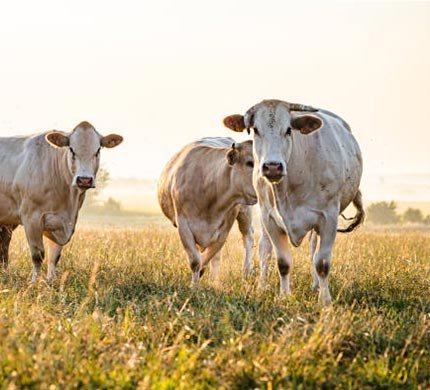Chianina
- Temperature:Hot and cold climates
- Milk:No milk production
- Food:Grass, Hay and other Forages
- Pregnancy:Approximately 9 months
- Nationality:Italy

General Information
Chianina is a breed of cattle that originated in central Italy, specifically in the regions of Tuscany, Umbria, and Lazio. They are one of the largest breeds of cattle in the world and are known for their impressive size and strength.
Chianina cattle have a white or straw-colored coat, and their skin is often pigmented with black or gray spots. They have long, straight horns and a distinctive hump over their shoulders.
Historically, Chianina cattle were used for agricultural work, such as pulling plows and carts, as well as for meat production. Today, they are primarily raised for their high-quality beef, which is lean and tender with a distinct flavor.
Where we find this cow to buy?
Chianina cattle are primarily raised for beef production, and they can often be found for sale through livestock markets, breed associations, and specialized beef producers.
If you are interested in purchasing Chianina cattle, it may be helpful to contact breed associations or other industry organizations in your area to learn more about available sources and breeding programs. You may also want to consult with local farmers or ranchers who are experienced in raising Chianina or other beef cattle breeds, as they may be able to provide additional insights and recommendations.
In some cases, you may be able to find Chianina beef products, such as steaks or ground beef, for sale through specialty meat markets or online retailers. However, availability may vary depending on your location and the specific market conditions in your area.

How to increase milk production in Chianina
Chianina cattle are not typically known for their milk production, as they are primarily raised for beef production. However, if you are interested in increasing the milk production of your Chianina cows, there are a few strategies that may be helpful:
01
Providing cows with a balanced, high-quality diet can help increase milk production.
02
Select Chianina bulls and cows with higher milk production genetics when breeding your herd to increase milk production.
03
Milking cows regularly and for an appropriate amount of time can help stimulate milk production.
04
Regular veterinary check-ups, vaccinations, and good management practices can help ensure cows produce milk at optimal levels.
Medicine
Like all cattle breeds, Chianina cattle may require medical treatment from time to time to help manage health issues or prevent disease. The types of medicines used for Chianina cattle are similar to those used for other breeds of cattle and may include:
01
AntibioticsAntibiotics should be used responsibly to prevent antibiotic resistance in Chianina cattle.
02
VaccinesVaccines are an important tool for preventing infectious diseases in Chianina cattle.
03
Parasite control medicationsParasite control medications help keep Chianina cattle healthy.
04
Pain relieversChianina cattle require pain relief medication to manage lameness, injuries pain.
Pregnancy
As the pregnancy progresses, it may be necessary to adjust the cow’s diet or provide additional supplements to ensure she is receiving the necessary nutrients for a healthy pregnancy.
Chianina cows can be bred using natural mating or artificial insemination. Once a cow is bred, it will typically take approximately 9 months, or 280-290 days, for the calf to be born.
It is important to provide a balanced diet, clean and comfortable housing, and monitor the cow’s health for signs of illness or injury.
Monitor both cow and calf closely for signs of health issues and provide colostrum within the first few hours of life to ensure a healthy start.
Important!
Overall, the pregnancy of Chianina cows requires careful management and attention to detail to ensure a successful outcome for both the cow and calf.
Food
Chianina cattle, like all cattle, require a balanced and nutritious diet to support their health, growth, and production. Here are some foods that may be included in the diet of Chianina cattle:
Chianina cattle require forage to support their digestive system, such as hay, pasture, silage, or other types of grasses or legumes.
Concentrates are high-energy feeds that supplement the forage portion of the diet, such as grains, wheat, and barley, as well as protein sources.
Access to clean, fresh water is essential for the health and well-being of Chianina cattle. Cattle require approximately 1-2 gallons of water per 100 pounds of body weight per day.
Chianina cattle require a balance of minerals and vitamins in their diet to support their overall health and productivity. This may include supplements such as salt, calcium, phosphorus, and vitamin A.
Facts
Here are some interesting facts about Chianina cattle:
Chianina cattle are one of the oldest cattle breeds in the world, originating from the Chiana Valley in central Italy.
Although Chianina cattle are primarily raised for beef production, they produce milk, with cows yielding an average of 3-4 gallons per day.
Chianina cattle are known for their lean muscle mass, which makes them a popular choice for beef production.
Chianina cattle are well adapted to a range of environments, from hot and humid climates to cold and mountainous regions.
Chianina cattle have been used in crossbreeding programs to improve the size and meat quality of other breeds, such as Hereford.
Chianina cattle have been traditionally used for draft purposes, and are still used for plowing and other agricultural tasks in some regions.
Chianina cattle are a rare breed, and efforts are being made to conserve and promote them.
Chianina cattle are known for their calm and docile temperament, which makes them easy to handle and work with.